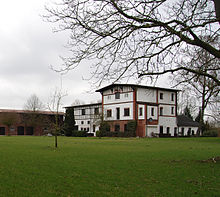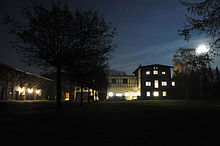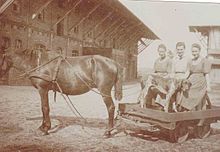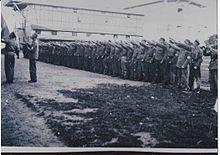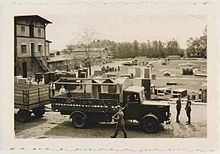Moorgut Karlshof

The Moorgut Karlshof is a former estate in Westerstede , the district town of the Ammerland district in northwest Lower Saxony . The Karlshof is located on the edge of the Fintlandsmoor . Today the former administrator's house, the large four-column barn and the former motor mill still exist. The motor mill, built around 1900, is one of the oldest reinforced concrete structures in Germany and has therefore been an individual monument since 2011 . The buildings of the Karlshof Moorggut have been a monument ensemble since 2011 .
The region between Apen , Bad Zwischenahn and Westerstede could be settled after 1933 thanks to the peat extraction of a 418 hectare bog operated by the Karlshof . From this the village of Karlshof developed in the following years . Historically, the Karlshof is of importance for historical commemoration due to its use as a “civil labor camp”, the presence of the Reich Labor Services and as a prisoner of war camp .
location
The Karlshof was built on a sand hill in the moor and borders to the north of the now renatured Fintlandsmoor, a nature reserve in Lower Saxony. This residual raised bog with an area of 141 hectares is characterized by small, structured areas of mesophilic grassland, peat birch forests, agricultural areas and rewetted peat cuttings. The NSG is part of FFH area 236 "Fintlandsmoor, Dänikhorster Moor". To the north of the Karlshof is the “Karlshof weekend area” with a swimming lake. The district of Karlshof forms the southern end of the city of Westerstede. The Karlshof can be reached via the Westerstede-Ocholt train station, which is three kilometers away. It is connected to local public transport via the Karlshof bus stop .
history
First potting and cultivation measures
The Fintland bog began to be cleared according to plan in 1877. First of all, a peat factory was founded and developed, and later, in parallel, a moorland was built in the Findlandsmoor. Two engineers, Meche from Bremen and Sander from Kleinheere near Hildesheim, bought 110 hectares of moorland from the Grand Ducal Oldenburg State Ministry at a price of 375 marks per hectare in what is now the Westerstede-Karlshof district. With one of the machines they had invented, they were able to extract large quantities of fuel peat. Mounted on pontoons and thus floatable, this machine, similar to an excavator, could be used in the not yet drained raised bog. In order to be able to dump as large areas as possible, the peat pits in which the excavator swam were laid out in a meandering manner. The peat obtained was dried in large sheds and then sold to the Oldenburg Railway, which ran largely with peat firing. To transport the peat, the plant built an approximately 3 km long narrow-gauge railway to what is now Westerstede-Ocholt's train station. The peat was pulled by horses. In 1879 the area of the peat factory was enlarged by 25 hectares. In 1880, a very wet summer resulted in a collapse during mining. The edges of the bags sagged and the peat did not dry in the shed. The leases were then terminated in 1881 and 76 hectares of the land were returned to the state. 34 hectares remained the property of the peat factory. When the Oldenburg Railway replaced peat firing with coal, the peat plant lost its livelihood. In 1884 the owners sold the peat factory to the Bremen businessman Carl Vellguth.
Origin of the "Carlshof" moorland
Carl Vellguth bought the remaining 34 hectares of raised bog for 200 marks per hectare, and at the same time leased another 65 hectares of raised bog for peat extraction. Although he continued the peat mill on these areas, his main line of business was a moorland on the already peated land, which the population called "Carlshof". In 1892 he enlarged his property to 57 hectares, 30 hectares of which he cultivated mainly as pastureland. The moorland developed steadily, the peat factory lost its importance, the debt and interest burden rose.
In 1893 Carl Vellguth stopped the peat extraction and only operated the moor estate. The grassland operation was expanded to include arable farming with a special form of bog cultivation: he covered the excavated high moor (approx. 10 ha) with clay , which he had transported from the Jade Bay by train and narrow-gauge railway to Karlshof. The enormous costs brought the property into financial difficulties, so that bankruptcy proceedings had to be opened in 1897.
The Karlshof Moorgut
In 1897 the value of the farms was estimated at 68,580 marks, the peat factory with inventory at 33,100 marks. The state of Oldenburg bought the moorland in 1897 for 40,000 marks and took it into self-administration through the state cultural fund. On the occasion of this takeover, the first map of the property was created. In 1898, the state of Oldenburg again sold the estate with 63.52 hectares of land including the field railway for 40,000 marks to Jean Balthazar (born August 27, 1857 in Cologne, † 1926 in Wiesbaden), a merchant from Bonn, who expanded it considerably. His heirs owned the estate between 1926 and 1932, but did not manage it themselves. Through acquisitions by the parishes of Westerstede and Apen, the property grew to a size of 418 hectares. Jaspers was the manager of the moorland for many years.
buildings

In 1900 Jean Balthazar erected new buildings in reinforced concrete , an innovative construction method at the time. The upper floors were built from half-timbered and brickwork on which a flat gable roof lies. The motor mill with the directly adjoining warehouses was built in reinforced concrete using a skeleton construction. Floors, ceilings and cellars were also made of reinforced concrete.
The barn, a two-story brick building, is a four-column house. It has a length of 23.30 m and a width of 16 m with a height of about 10 m. Like the former motor mill, the barn has a flat gable roof, with the special feature of a roof overhang of 4 m on one long side. In this barn, the harvest wagons with the harvest could be lifted to the first floor using rope hoists. The ceiling was erected in reinforced concrete on massive wooden supports.
Much of the former building was demolished between 1980 and 1985. Foundations can still be found. The barn is still unchanged today.
Purchase of the moor estate by the Oldenburg settlement office
In 1930 Albert August Balthazar, one of Jean Balthazar's sons, offered the Moorgut to the Oldenburg Settlement Office for purchase for 250,000 marks. From the settlement file S-3-2Ia-2 of the settlement office Oldenburg it emerges that the settlement office refused the purchase because there was not enough good arable land. In the next two years the following changed: The applications of those willing to settle increased, the purchase price sank to 125,000 marks, a new possibility of large-scale potting resulted from the newly established Strenge peat factory and the Reich Labor Service carried out drainage and cooling work on the uncultivated areas . The Oldenburg Settlement Office finally bought the moorland including the field railway for 125,000 marks in 1932. The 418 hectares of land are spread over 210 hectares of cultivated land, partly arable, partly pasture, 199 hectares of uncultivated moor, 9 hectares of roads and buildings. Already in spring the division and allocation of the colonies to the settlers began.
Moorgut Karlshof, the nucleus of the Karlshof moor colony
In the moor areas of the Karlshof intended for settlement, the state took over the expansion of the main receiving waters, the colonial border ditches , the expansion of the path and road network and provided school grounds according to a colony plan . The land was given to the settlers largely uncultivated. However, the colonists received financial support through melioration loans and cultivation grants.
Before the parcels were allocated, the Karlshof Moorgut carried out renovation work. For this purpose, the settlement office used the voluntary labor service and the Reich labor service . First of all, peatland areas with little peat had to be cooled by the labor services in order to create more arable land. From 1933 to 1938, around 150 men in the labor service cooled 76 hectares of moorland to a depth of 1 to 1.5 m. The power supply, which was guaranteed by a power plant on Moorgut Karlshof until 1933, took place from 1934 via the high-voltage line from Wiesmoor to Cloppenburg with a control center in Moorgut Karlshof. The individual settlers were later supplied with electricity from there.
According to the settlement plan, 35 colonies on 319 hectares were laid down in two steps in 1934, 22 of which were full farms with around 12 hectares, the most economical size at the time. The remaining 13 sites were set up to a size of 2 to 7 hectares. These were intended as part-time jobs for the hired workers at the Karlshof moor. Later they should be enlarged. According to the statements of the still living settlers, the colonists rejected the place name "Neuwiek" proposed by the settlement society for the newly founded settlement and insisted on the name "Karlshof".
Civil labor camp, prisoner of war camp and prisoner camp VII Esterwegen
In 1985, the Westerstede-Ocholt City Archives compiled the following data and facts from the documents that were in the archive:
Since 1940, Polish civilian workers, some with children, have been housed in massive buildings, who were used by Strenge, Ocholt, to extract peat from the moor. For this purpose, 30 French and Belgian prisoners of war were quartered, who were used to build roads in the Karlshof peasantry. Later they also did agricultural work on the estate. On May 21, 1942, around 50 Russian prisoners of war had already arrived, 65 Russian and Ukrainian civil workers, men and women, who were housed in barracks camps. Wehrmacht guards, some of which were based in the region, took them to work in the moor or in agriculture and brought them back again. 25 prisoners were transferred from the Esterwegen concentration camp to Karlshof. They also worked in the bog extracting peat. Ten French prisoners who were not used for work were also held. Shortly before the Allied troops marched in, the prisoners who were still in the camp were brought to a meeting point in Neuchâtel , Friesland district. The barrack camps were demolished.
Use since 1945
As early as 1941, Georg Oltmanns sen. part of the remaining material with 26 hectares of land. The buildings, built by Jean Balthazar, remained in the property of the settlement company after 1945 and were released for demolition. At the beginning of the 1950s, however, Oltmanns acquired these livestock buildings. Much of these buildings were demolished between 1980 and 1985. However, the motor mill made of reinforced concrete could not be "cut down" with the possibilities at the time. The 4-stand barn was preserved. In 1985 the property was divided again. Dietmar Bosold bought and renovated the former motor mill building and the barn with 1.2 hectares of land for private and commercial purposes. The manager's house, the former court of Carl Vellguth, built in 1876/77, remained in the possession of the Oltmanns. In 2011, Norbert Marten and Christel Mandos-Feldmann acquired part of the property from Bosold's possession (motor mill, barn, 1.2 hectares of forest, garden and green space), had it listed and are now planning the history of the Karlshof there to revive cultural memories and arts activities.
Web links
Individual evidence
- ↑ Behrens, Dietrich: Information about the development of the Karlshof colony, Oldenburg 1958, p. 6
- ^ Directory of cultural monuments, Lower Saxony State Office for Monument Preservation
- ↑ Information pages of the city of Westerstede ( Memento of the original from September 25, 2011 in the Internet Archive ) Info: The archive link was inserted automatically and has not yet been checked. Please check the original and archive link according to the instructions and then remove this notice.
- ^ The National Socialist Camp System, edited by Martin Weinmann, with contributions by Anne Kaiser and Ursula Krause-Schmitt, Frankfurt am Main: Zweiausendeins, 3rd edition 1999.
- ↑ List of companies that profited from forced labor under National Socialism. ( Memento from January 21, 2012 in the Internet Archive ) (PDF; 1.5 MB, preceded by an English summary), accessed on July 26, 2017.
- ^ Semester paper by H.-H. Rode, Ocholt, p. 14; 15th
- ↑ Behrens, Dietrich: Information about the development of the Karlshof colony, Oldenburg 1958, p. 6
- ↑ Information and archives of the former Strenge peat factory, Ocholt
- ↑ Behrens, Dietrich: Information on the development of the Karlshof colony, p. 7.
- ^ Semester paper by H.-H. Rode, Ocholt, p. 16.
- ↑ Behrens, Dietrich: Information on the development of the Karlshof colony, p. 10
- ↑ Grand Ducal Oldenburg Ministry of State, Department of the Interior, File VI-136-1Rb, Annex 1.
- ^ Grand Ducal Oldenburg Ministry of State, Department of the Interior, Act VI-136-1Rb, Annex 1, Appendix.
- ^ Tantzen, Richard: 75 Years of the Oldenburg Settlement Office, in: New Archives for Lower Saxony, Issue 10/12, Hannover 1954, p. 267
- ↑ Behrens, Dietrich: Information about the development of the Karlshof colony, Oldenburg 1958, p. 11.
- ^ Settlement Office, Karlshof settlement file, AZ: S-3-3IIa4.
- ^ Semester paper by H.-H. Rode, Oldenburg 1967 Ocholt, p. 16.
- ↑ City Archives Westerstede / Ocholt
Coordinates: 53 ° 10 ′ 36.7 ″ N , 7 ° 52 ′ 27.9 ″ E
